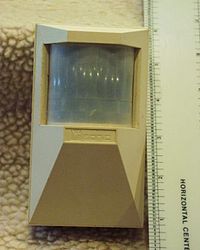
Photo from wikipedia
Precise recognition of near‐infrared (NIR) signals holds great prospects in optical communication, remote sensing, information security, and anti‐counterfeiting. For these applications, filters with good NIR transparency are typically essential components.… Click to show full abstract
Precise recognition of near‐infrared (NIR) signals holds great prospects in optical communication, remote sensing, information security, and anti‐counterfeiting. For these applications, filters with good NIR transparency are typically essential components. Currently, such NIR transparent filters are dominated by inorganic materials such as chalcogenide glasses. There are, so far, only a handful of organic molecules with suitable optical properties due to the rarity of organic materials with good NIR transparency and relatively flat absorption over the UV–visible region. Here, it is found that the library of NIR‐transparent organic materials can be expanded by forming a charge‐transfer complex (CTC) between a donor (D) and an acceptor (A) molecule that are commercially available. Via regulating the DA interaction, the CTC filter shows tunable absorption from the visible to NIR region with a relatively high penetration of NIR radiation (≈80%). The CTC filter can successfully highlight NIR information hidden in a complex environment and allow reading of NIR security images for advanced anti‐counterfeiting. Moreover, the CTC filter can be used for viewing protected NIR information with good resolution, and thus provide a convenient tool for different security applications using NIR‐encoded information.
Journal Title: Advanced Materials
Year Published: 2022
Link to full text (if available)
Share on Social Media: Sign Up to like & get
recommendations!